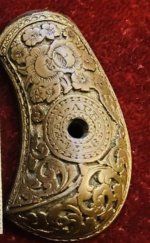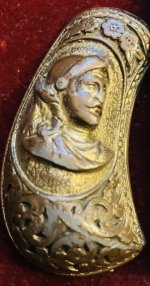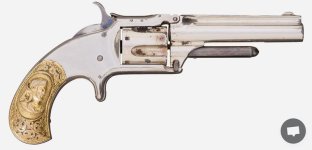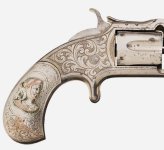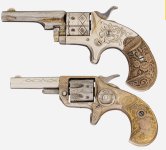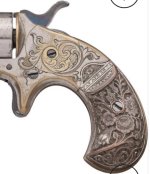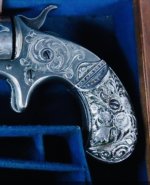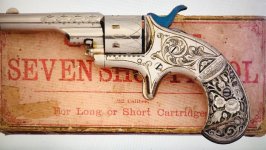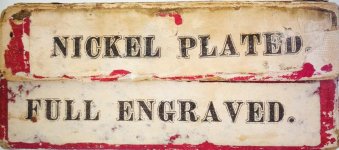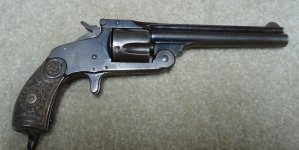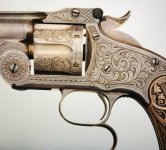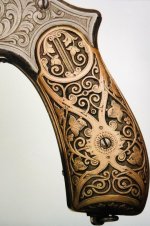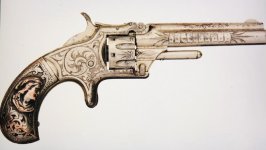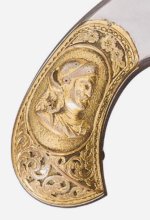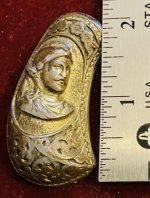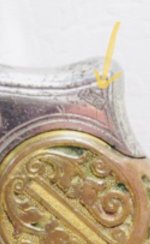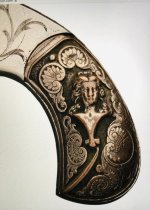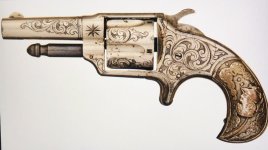Came across this biography of Francis De Gress.
No mention his pistol grips, but interesting nevertheless.
+++++++++++++++++++++++++++++++++++++++
Civil War Union Army Officer. Major of the 1st Illinois Artillery. He was born on the 4th day of February, 1841, at Cologne, Prussia, and when nine years old entered the Royal Military Academy at Bensberg, Prussia, where he remained until 1854. During that year he left the academy for the United States, and joined his father in New York. In 1856 he removed to Cape Girardeau, Mo., and learned watch-making in all its branches. At the breaking out of the civil war he responded to the first call for three months’ men, at the close of which time he joined, in January, 1862, as senior second lieutenant, Battery H, First Illinois Light Artillery, at Camp Douglas. On the 28th of February the battery arrived at Benton Barracks, St. Louis, to be equipped, and left for Pittsburg Landing April 3, 1862, having been attached to Gen. W.T. Sherman’s division. With his battery he took part in the battles of Pittsburg Landing and Shiloh, from thence in the siege of Corinth, the capture of Holly Springs, the battles of Chickasaw Bayou and Arkansas Post, participating in the siege of Vicksburg and all its battles. After the capture of Vicksburg he, on the 14th of July, 1863, took part in the siege and capture of Jackson, Miss. Capt. Hart, meanwhile, resigned and left the battery in command of Second Lieut. F. De Gress, the only officer with it, who commanded it ever afterwards. With his battery he participated in the campaign from Memphis to Chattanooga, and in the battles of Tuscumbia, Ala., and Mission Ridge or Lookout Mountain. Lieut. F. De Gress, whose term of enlistment had expired, was mustered into the service again as captain of his battery, every man re-enlisting as a veteran. On their arrival in Chicago a complimentary supper was given to the captain and his battery, at which Adjt. Gen. Fuller, in highly complimentary terms; presented Capt. F. De Gress with a very handsome sword as a token of esteem from the members of his battery, alluding to their various engagements and to the youthful commander. After predicting to Capt. De Gress a proud future, he presented the sword, as a token of esteem and confidence from the brave boys he had the honor and pleasure of commanding. Upon gold plates on the scabbard of the sword was an appropriate inscription, with the names of the battles and sieges in which he and the battery had been engaged. Capt. De Gress, in a soldier-like speech, brief and pertinent, acknowledged the unexpected present. At the expiration of their furlough Capt. De Gress and his battery returned to the seat of war, and were, May 1, 1864, assigned to the Second Division of Gen. Morgan L. Smith’s Fifteenth Army Corps, commanded by Maj. Gen. John A. Logan. They participated in the battles of Resaca, Dallas, Kenesaw Mountain, Nikajack Creek, Chatahoochee and all the battles of Atlanta, the battery being finally captured, the ensuing account of which appeared in Harper’s Weekly, Sept. 8, 1864: "Capt. De Gress, whose portrait is given on page 564, commands Battery H, First Illinois Artillery. The following gallant action is thus recorded by our correspondent: ‘On the 22d of July the battery of Capt. De Gress was placed, by order of Gen. Sherman, in such a position as to throw shells from his twenty-pounders into Atlanta. The rebels came charging through the railroad cut to the left of the battery. The supports gave way. De Gress saw at once that his guns were gone. He directly ordered his guns pointed left-oblique, and gave the charging rebels double canister, at the rate of four rounds per minute. Soon he had two of his guns spiked, and ordered his men to get away, remaining himself with one sergeant (Peter Wyman), using one gun as rapidly as possible. Still the enemy came on, and when within less than twenty steps an officer called to him to surrender. De Gress, who stood with the lanyard of either gun in his hands, shouted, "Certainly, come on!" at the same moment discharging his two guns, and called to Wyman, who stood with pincers and spikes, to spike under cover of the smoke and get away. De Gress saw the spike driven into the last gun, and as he started a storm of shot was sent after him. The sergeant was killed, but De Gress escaped uninjured. Gen. Logan, who was coming up at the head of Col. Martin’s brigade, was met by De Gress, who told the general that his guns were lost. "Oh, no, Captain," said the general, "Wood’s guns have been turned upon the horses of your battery, and I think those chaps will hardly get them away before I have this brigade charging clear over them." In less than a quarter of an hour De Gress, who had gone up with the charging column, was busy drawing the spike of one of his guns, which was very soon sending canister into the retreating rebels, the infantry officers near acting as cannoniers under the direction of Capt. De Gress, who has met with the sincere applause of the general officers who witnessed his gallantry. Capt. De Gress participated in the battle at Ezra Church, after which he was strongly recommended by Gens. Logan, Howard, Barry and others to the Governor of Illinois as colonel of the First Illinois Artillery, vice E. Taylor, who had resigned, which recommendations are now in the office of the Adjutant-General of Illinois. He also took part in battles of Jonesboro’ and the capture of Atlanta. At Gaylesville the army prepared for the grand march to the sea, Battery H, First Illinois Light Artillery being the only twenty-pounder Parrott battery allowed to participate, according to a special order of Gen. Sherman. Capt. De Gress was at the capture of Fort McAllister and Savannah, the battle and capture of Columbia, Bentonville, and arrived at Goldsboro’, N.C., March 25, 1865. He was present at the surrender of Johnson’s army at Raleigh, April 15, 1864, and from thence to Richmond, passed in review in Washington, and was mustered out in Springfield Ill., July 1, 1865, with the rank of major. Immediately after his retirement from the service Maj. De Gress formed a copartnership with several others and organized the firm of Wexel, De Gress & Co. They established themselves in Texas, with houses in Galveston, Brazos, Santiago, Brownsville, and agencies in several other towns on the frontier, and also in Monterey, Mexico. Maj. De Gress remained in Brownsville until the spring of 1868, and while there married Miss Isabella Greene, on the 26th of September, 1866. In the spring of 1868 he removed to the city of Mexico, whither his partner, Mr. Wexel, had preceded him, and established the first American arm-store, under the name of "Armeria Americana," by which name the firm was known all through Mexico. In 1869 he moved with his family to New York, leaving his partner in charge of the Mexican branches, where an office was opened. While in New York he established branches also in Central and South America. These he finally withdrew, wishing to concentrate all his capital in the Mexican trade. In 1872 he erected a house for his family on Chestnut Hill, between Bloomfield and Montclair, and resided there. In 1875 he exchanged places with Mr. Wexel, Maj. De Gress going to Mexico and Mr. Wexel to New York. On Maj. De Gress’ arrival business improved in Mexico, he taking advantage of every opportunity to extend the scope of his enterprise, confining himself not alone to arms and ammunition, but also to all kinds of machinery. He contracted to build docks for the government, as also arsenals, electric lights, telegraph lines, etc. In January, 1882, he effected a contract with the Mexican government to supply it with four million dollars in nickel coin. The business of this contract took him to Europe, accompanied by his wife and two of his children, the latter of whom he left at school in Bonn, Germany. After successfully arranging his affairs he returned to New York, and later to Mexico. Until this date he had been in good health, though soon after his return to Mexico he complained of indisposition, and finally departed for Vera Cruz, seeking there a change of air; from thence he repaired to Rimonada, where he peacefully passed away. His death was deplored by many; at the funeral, the Governor of the federal district of Mexico, the Minister of Finance, the Assistant Secretary of War and the Secretary of the Navy of Mexico being among his pall-bearers. Maj. De Gress joined the Masonic fraternity early in life, and at his death was a member of Bloomfield Lodge, No. 40, F. and A. M., Union Chapter, No. 7, Newark, and Damascus Commandery, No. 5, also of Newark, N.J. He was a member of Olive Branch Lodge, No. 51, I.O.O.F., at Bloomfield, N.J., and of the Grand Army of the Republic. His name is also mentioned a number of times in Gen. Sherman’s "Memoirs." He was one of the first vice-presidents of the Creedmoor Rifle Association. At the time of his death he was vice-president of the Mexican Oriental Railroad Company, known as the Gould-De Gress road. The remains of Maj. De Gress were buried in the American Cemetery, near the city of Mexico.
++++++++++++++++++++++++++++++++++++++++
∼
DeGress's Battery, Union Army. Civil War veteran.
He entered the federal service on January 1, 1862, in Cape Girardeau as a 2nd lieutenant with Battery H, 1st Illinois Light Artillery. On December 25, 1863 he was promoted to captain and took command of the battery which then became known as DeGress's Battery. He was mustered out on June 14, 1865.
His family had moved to Cape Girardeau from Germany when he was 11 years old and he took charge of his younger siblings when his father died when he was 13 years old.
He received recogition during the siege of Vicksburg and was with Sherman on his march to the sea in Georgia.
At the end of the war he went into business at Brownsville, Texas with the company of Wexel & DeGress. They soon expanded to Matamoros, Mexico and in 1868 to Mexico City. From there they set up branches in Chile and Peru in South America. At first they sold firearms during the constant wars but after peace came sold farm implements and machinery.
At his funeral the pallbearers consisted of high ranking Mexican officials and foreign dignataries plus his wife and two children. His widow, Isabele Gordon, applied for a pension in his name in the 1890's in New Jersey. She frequently moved back and forth between the US and Mexico over the years.
___________________________________________________
Swords presented to Francis DeGress.
Pistol carried by DeGress.
Battle of Atlanta
"Degress's Battery" . The 66th Iliinois Volunteers (Western Sharpshooters) retakes a captured Union Battery during the battle of Atlanta.
Regards,
bcowern

